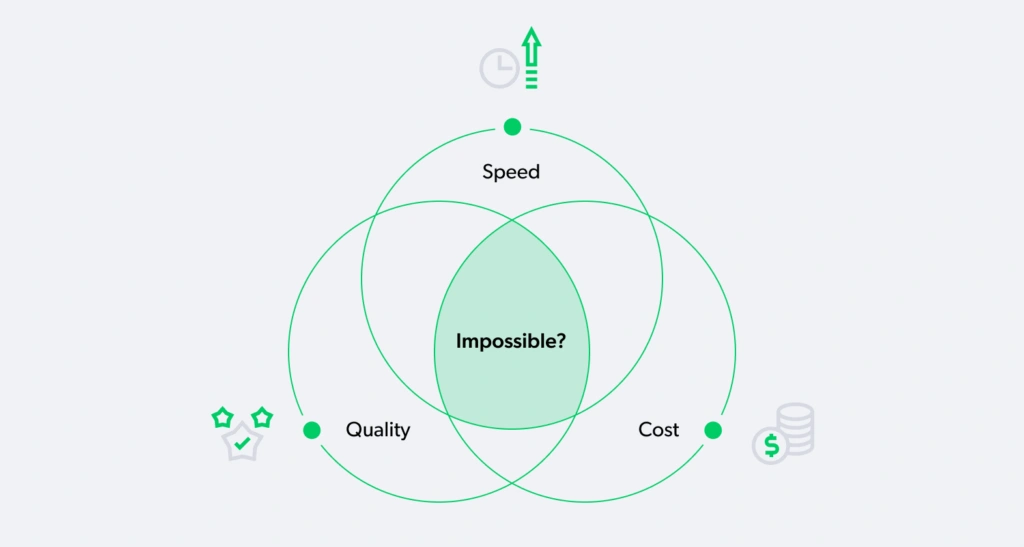This article will take you on an exciting journey through the world of Continuous Integration/Continuous Delivery (CI/CD) and explain to you why it’s a game-changer for businesses. Discover the cutting-edge benefits of test automation and how it can supercharge IT projects across a wide variety of industries. From smoother workflows to increased productivity and profitability, this article explores the endless possibilities of test automation and its positive outcomes for businesses.
How test automation has evolved
Automation has come into many spheres of our life. We don’t have to wash our clothes anymore, as the washing machine can do it for us instead. We don’t have to vacuum our carpets anymore as an automatic vacuum cleaner can go from room to room and do it for us. Today’s software testers only need to do a little bit of manual testing. Instead, they focus mostly on writing code that will automatically check the quality of the produced software with CI/CD.
You can still wash your clothes manually, vacuum the floor by yourself, or do manual software testing. However, if you want efficiency, speed, and quality, you know what to choose!
The global statistics also show a dramatic increase in the use of automated testing. For example, according to research by Markets and Markets, the automation testing market is going to increase from $20.7 billion in 2021 to $49.9 billion by 2026. It’s all become possible thanks to the advancement and more active usage of new methods and tools (such as CI/CD testing as well as other DevOps instruments). Even though test automation came on the market over a decade ago, a lot of companies still are not taking advantage of it and unfortunately they’re still underestimating its huge potential.
Note: We’re not trying to imply that there’s no need to perform manual testing anymore. There’s still a role for it as it’s impossible to do projects completely without some manual testing. Test automation helps reduce the amount of manual testing needed dramatically which makes developing software much easier.
The software development process using CI/CD compared to building a skyscraper
Let’s compare software development with building a skyscraper. Imagine the following situation. To build a skyscraper, you hire a team of highly professional architects, engineers, and builders. They’ve almost completed the construction, however since a skyscraper is a highly complex building that requires the involvement of hundreds of people, they didn’t notice several small mistakes that were made at the very beginning. In order to correct these early mistakes it will be necessary to dismantle one-third of the skyscraper! Imagine the huge cost of such a mistake and its consequences in terms of efficiency. This preventable domino effect wasted the good work of numerous professionals.
The same situation can easily take place in a software development company. You hire a company to develop an application. The developers create the code. Let’s say it takes them 6 months. Then, after the code is completed, they pass it over to the testers, who find a piece of code that was written at the beginning that doesn’t work correctly. Then, the domino effect takes place, and hundreds of bugs appear later on since connectivity between the different parts of the code is broken. The project ends up becoming a nightmare that costs you an enormous amount of extra time and effort.
Is it possible to avoid these types of situations?
Yes. The agile approach and usage of CI/CD makes the above-described situation almost impossible.
What CI/CD is and the benefits of a streamlined CI/CD pipeline
Continuous integration, continuous delivery, and continuous deployment (CI/CD/CD) are approaches to software development where monitoring and automation are implemented at every stage of the app’s development. The goal of these processes is to find problems early on to help prevent “integration hell” (the relationship and dependency between the code that is built and the remaining code in the system).
The usage of CI/CD yields following benefits through the optimization of the workflow:
- Boosted productivity and confidence of the developers
- Shortened feedback loop between the developers and the test results
- Upgraded code quality
- Improved test reliability and fault detection because automation tools never miss a detail
- Reduced number of changes needed
- Fewer amounts of bugs and defects found by manual testers
- Quicker resolutions
- Better opportunities for collaboration and feedback by contributors
- Increased code deployment frequency with lower risk and fewer resources needed
- Improved software testing with automated integration tests
- Cost reductions and increased client satisfaction thanks to the optimization of operational processes
- Enhanced ability to deliver products that meet user needs
CI/CD testing helps you deliver faster, better, cost-effective software solutions
What does a business want when it comes to hiring a software development company? It wants a perfect balance between speed, quality, and cost.

Until recently, it was impossible to combine all three, and you had to pick and choose the most optimal one. But now with the introduction of Continuous Integration and Continuous Delivery as well as the testing pyramid approach, the impossible has now become possible! Thanks to the usage of open-source test automation tools, CI/CD should no longer be considered as an expensive tool that companies can’t afford. According to the study by Simform, 46.7% of companies currently use open-source test automation tools in their organization, which saves them a lot of time and money.
CI/CD test automation is like having a reliable GPS navigator that guides you through the twists and turns of software development, helping you avoid obstacles and reach your destination faster.
Sergey Zagriychuk, Head of Java Competency Center at Solvd
Real-world cases that demonstrate the effectiveness of CI/CD test automation
There are many success stories that demonstrate the efficiency of CI/CD test automation. For example, thanks to CI/CD, Spotify managed to decrease the time from set-up to the first build and deployment down from 14 days to 5 minutes. They did it by using a CI/CD tool, which automatically builds and deploys the projects. Similarly, thanks to automation testing in the CI/CD pipeline, HP Laserjet Firmware Group managed to decrease their regression testing time down from 6 weeks to 24 hours. They learned that long feedback cycles make it more difficult to prevent mistakes in the future and that slow development cycles curb new feature development and creativity. Another prominent example of the effectiveness of CI/CD and test automation is the case of Lloyds Banking Group. They managed to decrease the testing cycle time down from 9 to 4 days, while also ensuring a 200% faster time to market. The list of success stories can be continued extensively since there are many different companies that demonstrate CI/CD testing’s efficiency.
Takeaways
Thanks to CI/CD and the usage of the agile approach, the processes of developing and deploying software has become more quick and efficient. For example, today companies can release new products not only every year, or every half a year, but once a quarter or even once a month. This way of doing business allows for the driving of new features, new customers, and more revenues.
Continuous integration and continuous deployment require sharp management to be completed properly since all the processes must be optimized, and the personnel involved must be very disciplined. It’s necessary to ensure that the key tests and verifications are easy to maintain, and they also must be available on demand. Ensuring this is one of the top priorities for managers when they’re starting a DevOps project.









